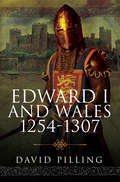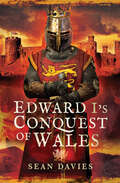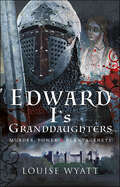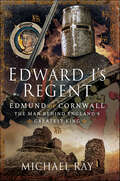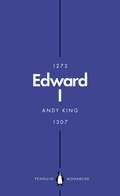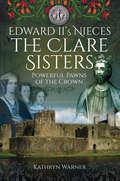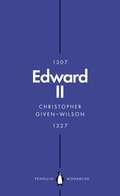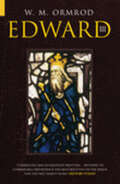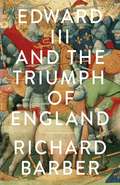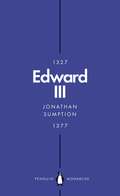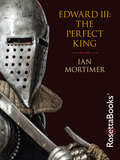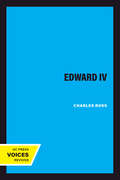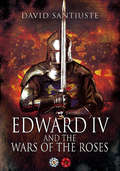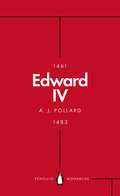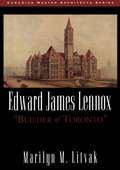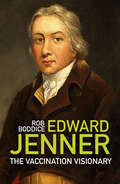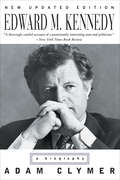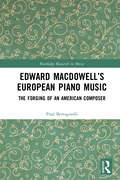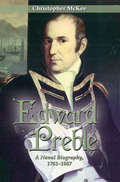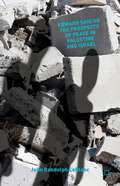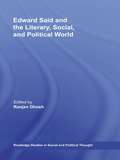- Table View
- List View
Edward I and Wales, 1254–1307
by David PillingThe late 13th century witnessed the conquest of Wales after two hundred years of conflict between Welsh princes and the English crown. In 1282 Llywelyn ap Gruffudd, the only native Prince of Wales to be formally acknowledged by a King of England, was slain by English forces. His brother Dafydd continued the fight, but was eventually captured and executed. Further revolts followed under Rhys ap Maredudd, a former crown ally, and Madog ap Llywelyn, a kinsman of the defeated lords of Gwynedd. The Welsh wars were a massive undertaking for the crown, and required the mobilization of all resources. Edward’s willingness to direct the combined power of the English state and church against the Prince of Wales, to an unprecedented degree, resulted in a victory that had eluded all of his predecessors. This latest study of the Welsh wars of Edward I will draw upon recently translated archive material, allowing a fresh insight into military and political events. Edward’s personal relationship with Welsh leaders is also reconsidered. Traditionally, the conquest is dated to the fall of Llywelyn in December 1282, but this book will argue that Edward was not truly the master of Wales until 1294. In the years between those two dates he broke the power of the great Marcher lords and crushed two further large-scale revolts against crown authority. After 1294 he was able to exploit Welsh manpower on a massive scale. His successors followed the same policy during the Scottish wars and the Hundred Years War. Edward enjoyed considerable support among the ‘uchelwyr’ or Welsh gentry class, many of whom served him as diplomats and spies as well as military captains. This aspect of the king’s complex relationship with the Welsh will also feature.
Edward I and the Governance of England, 1272-1307
by Caroline BurtThis important exploration of the reign of Edward I – one of England's most lionised, feared and successful monarchs – presents his kingship in a radical new light. Through detailed case studies of Shropshire, Warwickshire and Kent, Caroline Burt examines how Edward's governance at a national level was reflected in different localities. She employs novel methodology to measure levels of disorder and the effects of government action, and uncovers a remarkably sophisticated approach to governance. This study combines an empirical examination of government with an understanding of developing political ideas and ideological motivation and contributes towards a greater understanding of the development of local government and politics in England in the thirteenth and fourteenth centuries. Edward emerges as a king with a coherent set of ideas about the governance of his realm, both intellectually and practically, whose achievements were even more remarkable than has previously been recognised.
Edward I's Conquest of Wales
by Sean DaviesA study of medieval warfare and a formative event in the history of Britain. Edward I&’s conquest of Wales has not been the subject of a scholarly book for over a century. Research has advanced since then, changing our perception of the medieval military mind and shining fresh light on the key characters involved in the conquest. That is why Sean Davies&’s absorbing new study is so timely and important. Taking a balanced approach, he gives both the Welsh and English perspectives on the war and on the brutal, mistrustful, and ruthless personal motives that drove events. His account is set in the context of Welsh warfare and society from the end of Rome to the time of Edward&’s opening campaign in the late thirteenth century. The narrative describes in vivid detail the military history of the conflict; the sequence of campaigns; Welsh resistance; Edward&’s castle building and English colonization; the cost of the struggle to the Welsh and the English; and the uneasy peace that followed.
Edward I's Granddaughters: Murder, Power & Plantagenets
by Louise WyattEdward I and his offspring, especially Edward II, are not shrouded by the mists of time. Edward I’s two sons and daughter by his second marriage are lesser known, especially the eldest, Thomas Plantagenet of Brotherton. He made no particular impression on history, despite being Earl of Norfolk and Earl Marshal, but Thomas did father three children. Of these, only one is usually remembered: Margaret of Norfolk. Indomitable, defiant, respected and fiercely intelligent, she defied her cousin Edward III more than once and outlived most of her family. Her brother Edward of Norfolk died young but her sister, Alice of Norfolk, survived childhood. But not for long. In 1338, by the time she was fourteen, Alice was married to Sir Edward Montagu, younger brother of the famous earl of Salisbury, William Montagu and Bishop of Ely, Simon Montagu. Edward was a warrior knight at Crecy, involved in the wars with Scotland, loyal to his brother and his king. The marriage produced five children within a decade, but by 1350 Edward Montagu was showing his dark side and was part of the knightly criminal gangs that terrorized local areas. One day in June 1351, Alice of Norfolk paid the price. Despite being a Plantagenet, daughter of an earl, granddaughter, niece and cousin to kings, Alice of Norfolk has mostly been forgotten. Even looking at contemporary records, Alice hardly features apart from land and property dealings with her husband. A dusty reference to the unfortunate circumstances of her death marks the end of her life and one which will more than likely remain a mystery.
Edward I's Regent: Edmund of Cornwall, The Man Behind England’s Greatest King
by Michael RayBorn at Christmas 1249 to Richard, Edmund of Cornwall was nephew to Henry III and cousin to Edward I. His eventful childhood took him to Germany when his father was elected king there. He was captured at the battle of Lewes and imprisoned for more than a year. Returning from crusade, he witnessed the brutal murder of his half-brother, which left him as heir to his father, the richest man in the kingdom. Throughout his life, Edmund played a crucial role in medieval England. As Regent of England, Earl of Cornwall and the richest man in the land, he was a leading force of the late-thirteenth century. This book considers Edmund’s life, his use of his wealth to lend to the king and others and to be a major benefactor of religious houses. His piety saw him found two new religious houses, rebuild another and bring the Holy Blood relic from Germany to Hailes abbey. His record as Regent of England for three years is assessed. The wide spread of his lands, which included 13castles and more than 800 places in 27 counties, and his tenants are set out as is his place in the local community. The basis of his wealth and its sources, including money from his lands but also from tin mining and marine dues in Cornwall, is explored and his knightly affinity and his close associates and officials are considered. On a personal level, the book examines his unsuccessful, childless marriage with the sister of the Earl of Gloucester. Edmund was a key figure throughout Edward I's rein and the late-thirteenth century. In this insightful account, the man behind England's 'greatest king' is at long last brought to the fore.
Edward I: A New King Arthur? (Penguin Monarchs)
by Andy KingThe acclaimed Penguin Monarchs series: short, fresh, expert accounts of England's rulers - now in paperbackEdward I (1272-1307) is one of the most commanding of all English rulers. He fought in southwest France, in Wales, In Scotland and in northern France, he ruled with ruthlessness and confidence, undoing the chaotic failure of his father, Henry III's reign. He reshaped England's legal system and came close to bringing the whole island of Great Britain under his rule. He promoted the idea of himself as the new King Arthur, his Round Table still hanging in Winchester Castle to this day. His greatest monuments are the extraordinary castles - Caernarfon, Beaumaris, Harlech and Conwy - built to ensure his rule of Wales and some of the largest of all medieval buildings.Andy King's brilliant short biography brings to life a strange, complex man whose triumphs raise all kinds of questions about the nature of kingship - how could someone who established so many key elements in England's unique legal and parliamentary system also have been such a harsh, militarily brutal warrior?
Edward II's Nieces, The Clare Sisters: Powerful Pawns of the Crown
by Kathryn Warner“A great book to introduce you to three fascinating sisters whose marriages during the reign of the infamous Edward II transformed England.” —Adventures of a Tudor NerdThe de Clare sisters Eleanor, Margaret and Elizabeth were born in the 1290s as the eldest granddaughters of King Edward I of England and his Spanish queen Eleanor of Castile, and were the daughters of the greatest nobleman in England, Gilbert “the Red” de Clare, Earl of Gloucester. They grew to adulthood during the turbulent reign of their uncle Edward II, and all three of them were married to men involved in intense, probably romantic or sexual, relationships with their uncle.When their elder brother Gilbert de Clare, Earl of Gloucester, was killed during their uncle’s catastrophic defeat at the battle of Bannockburn in June 1314, the three sisters inherited and shared his vast wealth and lands in three countries, but their inheritance proved a poisoned chalice. Eleanor and Elizabeth, and Margaret’s daughter and heir, were all abducted and forcibly married by men desperate for a share of their riches, and all three sisters were imprisoned at some point either by their uncle Edward II or his queen Isabella of France during the tumultuous decade of the 1320s. Elizabeth was widowed for the third time at twenty-six, lived as a widow for just under forty years, and founded Clare College at the University of Cambridge.“Another enjoyable read on women in history that don’t always get the limelight that they deserve. Kathryn Warner has done it once again by providing a well-written, well-researched, informative and engaging read.” —Where There’s Ink There’s Paper
Edward II: The Terrors of Kingship (Penguin Monarchs)
by Christopher Given-Wilson'He seems to have laboured under an almost child-like misapprehension about the size of his world. Had greatness not been thrust upon him, he might have lived a life of great harmlessness.'The reign of Edward II was a succession of disasters. Unkingly, inept in war, and in thrall to favourites, he preferred digging ditches and rowing boats to the tedium of government. His infatuation with a young Gascon nobleman, Piers Gaveston, alienated even the most natural supporters of the crown. Hoping to lay the ghost of his soldierly father, Edward I, he invaded Scotland and suffered catastrophic defeat at the Battle of Bannockburn. After twenty ruinous years, betrayed and abandoned by most of his nobles and by his wife and her lover, Edward was imprisoned in Berkeley Castle and murdered - the first English king since the Norman Conquest to be deposed.
Edward III
by W M OrmrodThe fifty-year reign of one of England's most charismatic leaders is assessed in this lucid and incisive work. W.M. Ormrod traces Edward's life from his birth, when the very future of the monarchy in England was under threat, to his death when he was regarded throughout Europe as the very model of an ideal monarch.
Edward III and the Triumph of England: The Battle of Crécy and the Company of the Garter
by Richard BarberA fascinating recreation of the world of one of England's most charismatic monarchs, from award-winning author and historian Richard BarberThe destruction of the French army at Crécy in 1346 and the subsequent siege and capture of Calais marked a new era in European history. The most powerful, glamorous and respected of all western monarchies had been completely humiliated by England, a country long viewed either as a chaotic backwater or a mere French satellite.The young Edward III's triumph would launch both countries, as we now know, into a grim cycle of some 90 years of further fighting ending with English defeat, but after Crécy anything seemed possible - Edward's claim to be King of France could be pressed home and, in any event, enormous rewards of land, treasure and prestige were available both to the king and to the close companions who had made the victory possible. It was to enshrine this moment that Edward created one of the most famous of all knightly orders, the Company of the Garter.Barber writes about both the great campaigns and the individuals who formed the original membership of the Company - and through their biographies makes the period tangible and fascinating. This is a book about knighthood, battle tactics and grand strategy, but it is also about fashion, literature and the privates lives of everyone from queens to freebooters. Barber's book is a remarkable achievement - but also an extremely enjoyable one.Reviews:'Barber [has an] infectious passion for and deep knowledge of his subject matter ... elegant prose and rigorous historical analysis ... a valuable and thorough addition to the body of work on this most impressive of English monarchs' Sunday Times'In Edward III and the Triumph of England [Barber] has written the kind of book that the king would have enjoyed: full of battles, glitter and ceremony ... he has an original eye and an elegant pen' Jonathan Sumption, Literary Review'Barber share's his hero's love of chivalry ... The book sparkle[s] with some of Edward's own glitz' Telegraph'This absorbing book is layered rather than linear, sifting with uncommon sensitivity through challenging sources to test the boundaries of what we can and cannot know ... We discover the complexity of the world in which Edward and his commanders lived' Helen Castor, The TimesAbout the author:Richard Barber has had a huge influence on the study of medieval history and literature, both as a writer and as a publisher. His major works include The Knight and Chivalry (winner of the Somerset Maugham Award), Edward Prince of Wales and Aquitaine, The Penguin Guide to Medieval Europe and The Holy Grail: The History of a Legend. He lives in East Anglia.
Edward III: A Heroic Failure (Penguin Monarchs)
by Jonathan SumptionEdward III lived through bloody and turbulent times. His father was deposed by his mother and her lover when he was still a teenager; a third of England's population was killed by the Black Death midway through his reign; and the intractable Hundred Years War with France began under his leadership. Yet Edward managed to rule England for fifty years, and was viewed as a paragon of kingship in the eyes of both his contemporaries and later generations. Venerated as the victor of Sluys and Crécy and the founder of the Order of the Garter, he was regarded with awe even by his enemies. But he lived too long, and was ultimately condemned to see thirty years of conquests reversed in less than five. In this gripping new account of Edward III's rise and fall, Jonathan Sumption introduces us to a fêted king who ended his life a heroic failure.
Edward III: The Perfect King
by Ian MortimerA look at the brutal, brilliant fourteenth-century ruler, by the bestselling author of The Time Traveler&’s Guide to Medieval England. Holding power for over fifty years starting in 1327, Edward III was one of England&’s most influential kings—and one who shaped the course of English history. Revered as one of the country&’s most illustrious leaders for centuries, he was also a usurper and a warmonger who ordered his uncle beheaded. A brutal man, to be sure, but a brilliant one. Noted historian Ian Mortimer offers the first comprehensive look at the life of Edward III. The Perfect King was often the instigator of his own drama, but he also overthrew tyrannous guardians as a teenager and ushered in a period of chivalric ideals. Mortimer traces how Edward&’s reforms made feudal England a thriving, sophisticated country and one of Europe&’s major military powers. Ideal for anyone fascinated by medieval history, this lively book provides new insight into Edward III&’s lasting influence on the justice system, artistic traditions, language, and architecture of the country. &“The most remarkable medieval historian of our time.&” —The Times (London)
Edward IV
by Charles RossIn his own time Edward IV was seen as an able and successful king who rescued England from the miseries of civil war and provided the country with firm, judicious, and popular government. The prejudices of later historians diminished this high reputation, until recent research confirmed Edward as a ruler of substantial achievement, whose methods and policies formed the foundation of early Tudor government. This classic study by Charles Ross places the reign firmly in the context of late medieval power politics, analyzing the methods by which a usurper sought to retain his throne and reassert the power of a monarchy seriously weakened by the feeble rule of Henry VI. Edward's relations with the politically active classes—the merchants, gentry, and nobility—form a major theme, and against this background Ross provides an evaluation of the many innovations in government on which the king's achievement rests.
Edward IV
by Charles RossThis title is part of UC Press's Voices Revived program, which commemorates University of California Press’s mission to seek out and cultivate the brightest minds and give them voice, reach, and impact. Drawing on a backlist dating to 1893, Voices Revived makes high-quality, peer-reviewed scholarship accessible once again using print-on-demand technology. This title was originally published in 1974.
Edward IV (Routledge Historical Biographies)
by Hannes KleinekeDrawing together both recent research and original sources, this concise and accessible biography reassesses the debates surrounding the life of King Edward IV.The reign of King Edward IV occupies a pivotal place in late medieval English history, marking the transition from a medieval to a renaissance monarchy, yet there has been much controversy over the King's character. Was Edward a vain and self-indulgent playboy, or was his life cut tragically short? Offering readers insight into the latest scholarship, this second edition has been updated and revised to include a wider consideration of the role of women at Edward’s court, including his mother Cecily of York, as well as Edward’s own attitude to women and family. Kleineke also includes an extended discussion of Edward’s legacy, the government of England in the 1470s, and the cultural history of the period.As fascinating a character now as he was for Shakespeare over four centuries ago, Edward IV remains essential reading for all students of late medieval England, the Wars of the Roses, and all those interested in the history of monarchy more broadly.
Edward IV and the Wars of the Roses
by David SantiusteThis fascinating account of an unsung English monarch and military leader is &“a pleasing and well-informed appraisal of the first Yorkist king&” (Dr. Michael Jones, author of Bosworth 1485: Psychology of a Battle). Indisputably the most effective general of the Wars of the Roses in fifteenth-century England, King Edward IV died in his bed, undefeated in battle. Yet he has never been accorded the martial reputation of other English warrior kings such as Henry V. It has been suggested that perhaps he lacked the personal discipline expected of a truly great army commander. But, as the author shows in this perceptive and highly readable new study, Edward was a formidable military leader whose strengths and subtleties have never been fully recognized—perhaps because he fought most of his battles against his own people in a civil war. This reassessment of Edward&’s military skill—and of the Wars of the Roses in which he played such a vital part—provides fascinating insight into Edward the man as well as the politician and battlefield commander. Based on contemporary sources and the latest scholarly research, Edward IV and the Wars of the Roses stands as &“a valuable and thought-provoking addition to the canon, which ought to become required reading for anyone interested in the reign of the first Yorkist monarch&” (The Ricardian).
Edward IV: The Summer King (Penguin Monarchs)
by A J PollardIn 1461 Edward earl of March, an able, handsome, and charming eighteen-year old, usurped the English throne from his feeble Lancastrian predecessor Henry VI. Ten years on, following outbreaks of civil conflict that culminated in him losing, then regaining the crown, he had finally secured his kingdom. The years that followed witnessed a period of rule that has been described as a golden age: a time of peace and economic and industrial expansion, which saw the establishment of a style of monarchy that the Tudors would later develop. Yet, argues A. J. Pollard, Edward, who was drawn to a life of sexual and epicurean excess, was a man of limited vision, his reign remaining to the very end the narrow rule of a victorious faction in civil war. Ultimately, his failure was dynastic: barely two months after his death in April 1483, the throne was usurped by Edward's youngest brother, Richard III.
Edward James Lennox: "Builder of Toronto"
by Marilyn M. LitvakFrom 1876 to 1915, Edward James Lennox was a formidable force in Toronto’s architectural community. Many of his buildings are still landmarks in a city that continues to evolve.Born and educated in Toronto, Lennox looked to the past for inspiration but was never captured by it. His prototypical Annex houes on Madison Avenue, Old City Hall, and Casa Loma bear witness to his technical expertise and aesthetic sensibilities. Through text and illustrations, this volume tells the story of the a resolute architect whose vision helped shape an emerging city, and who in his time was called the "builder of Toronto."Edward James Lennox, "Builder of Toronto" is the first volume in the Canadian Master Architect series. Each publication will profile the work of an individual Canadian architect. The series editor is Marilyn M. Litvak.
Edward Jenner: The Vaccination Visionary (Pocket GIANTS)
by Rob BoddiceEdward Jenner is a giant of modern medicine. Throughout history, smallpox had plagued humanity with disfigurement, blindness and death. It was an incurable blight, the suffering of which Jenner helped to end.Surmising from the immunity of milkmaids that cowpox might be some defence against the ravages of smallpox, in 1793 he took some of the matter from a human case of cowpox and inserted it into the arm of a young boy. To test this, the first human-to-human vaccination, he subsequently inoculated the boy with smallpox itself, and found him to be immune from the disease. In 1979 smallpox was declared extinct.In this concise biography, Rob Boddice tells the story of Jenner’s life, his medical vision and his profound legacy. It is a story that encompasses revolutions in medical experimentation, public health provision and the prevention of other diseases, from anthrax to measles, but above all it highlights the profound impact that Jenner’s vision has had upon humanity’s battle against disease.
Edward Longshanks (Plantagenet Saga #7)
by Jean PlaidyHenry III had died and his son Edward, called Longshanks on account of his long legs and fine physique, was on his way home from the Holy Land with his wife, Eleanor, who had saved his life--some said--when she had sucked poison from a wound he had received from a would-be assassin. Edward was the strong man the country needed and he was dedicated to its service. His weakness was his love for his children and in particular his daughters with whom he could not bear to part even in marriage. There was the eldest and his favourite, the Princess Eleanor, who, marrying late enjoyed but brief happiness before tragedy overtook her; wild Joanna, born in Acre, defied her father when she married secretly; Margaret was married to a libertine and forced to receive his bastards; Mary was destined by her forceful grandmother for a convent; and Elizabeth married first for state reasons and the second time insisted on choosing for herself. Edward was the devoted family man, with his docile wife whom he loved so much that on her death he caused crosses to be set up where her coffin came to rest on its journey from Lincoln to London. His second marriage with the sister of the King of France was equally felicitous. It was his son who caused him great anxiety, for young Edward had surrounded himself with companions of questionable morals, chief of them, Piers Gaveston, who had begun to dominate the young Prince. These were stirring times and Edward's ambition was to unite the kingdoms of England, Scotland and Wales under his rule. Llewellyn of Wales loved the Demoiselle, daughter of Simon de Montfort, but their love story ended in tragedy and the submission of Wales. In Scotland the great hero, William Wallace, had appeared, and Wallace's adventures had made him a legend, but his need of women was to result in his fearful end at the hands of Edward. Edward Longshanks dominated his age. He was the great ruler, strong, just, cruel when he considered it necessary, vunerable only where his family was concerned. He emerges as one of the greatest kings England has ever known. His tragedy was that he died knowing that his work was incomplete and that the crown must pass to his dissolute son.
Edward M. Kennedy: A Biography
by Adam ClymerEdward M. Kennedy is one of the most influential senators in Congress. For the last 35 years, he′s played a major role in events ranging from the Vietnam War to Supreme Court confirmations. He′s also been closely associated with issues such as health care, civil rights and campaign finance reform. More than the foremost lawmaker and best orator in the Senate, he′s enthralled (and disappointed) a generation who saw him as the keeper of his famous brothers′ flame. He′s seen America -- and her politics -- change in drastic ways. In this definitive biography, New York Times Washington Editor Adam Clymer draws an in-depth portrait of this complex man. Through interviews with Kennedy, and the people close to him, he places Kennedy′s career in a historical perspective, and observes how Kennedy′s personal life has affected his political performance. The Senator has dealt with his infamous legacy, struggled to overcome the Chappaquiddick incident, and handled spectacular failures as well as many truimphs. He′s one of the few old-fashioned liberals who has held the Democratic Party to its principles, and is a hero to many. This is a unique, enormously readable chronicle of one of the most fascinating political figures of our time.
Edward MacDowell’s European Piano Music: The Forging of an American Composer (Routledge Research in Music)
by Paul BertagnolliEdward MacDowell’s European Piano Music is a critical study of the piano music that MacDowell composed during his European sojourn (1876–1888), steeped in reception history and with a special emphasis of programmaticism.The book expands current knowledge of MacDowell’s childhood in four of the chapters based on his previously uninvestigated sheet music collection, thereby achieving a better balance among the stages of MacDowell’s life than is evident in most books of the life-and-works variety. Prolific contemporaneous music criticism, meticulously preserved in MacDowell’s scrapbooks, is likewise undervalued in the MacDowell literature, but it furnishes penetrating observations about the expressive and programmatic content of numerous compositions, especially as it was revealed to critics when MacDowell performed his own works. Lastly, the book offers explanations for why MacDowell immersed himself in European culture for decades and then, at a crucial juncture in his career, embraced diverse American heritages and worked toward a conception of a pluralistic music that was American “in a creative sense.”The book’s content and methodology would appeal most directly to specialists within the broad fields of musicology and music theory, particularly within American art music and its composers; nineteenth-century music; program music; reception history; and piano literature.
Edward Preble
by Christopher MckeeOriginally published in 1972, Christopher McKee's biography of Edward Preble remains the most authoritative source on this influential early shaper of the U.S. naval tradition. McKee (Grinnell College) documents Preble's rise from obscurity to become Thomas Jefferson's chief administrator, his relationship with Jefferson and the president' policies and strategies during the war, and also the Tripolitan activities and attitudes which confronted Preble as he sought to bring the war to an end. This Classic of Naval Literature work includes illustrations and a new introduction by the author.
Edward Said On The Prospects Of Peace In Palestine And Israel
by John Randolph LeblancJohn Randolph LeBlanc examines the political oeuvre of critic and activist Edward Said and finds that Said preferred "reconciliation" to segregation in Palestine/Israel. LeBlanc argues that Said's criticism speaks to the importance of negotiating the troubling, proximate, and unsettling presence of our most perplexing others.
Edward Said and the Literary, Social, and Political World (Routledge Studies in Social and Political Thought)
by Ranjan GhoshEdward Said is widely recognized for his work as a critic and theorist of Orientalism and the Palestine crisis, but far less attention has been devoted to his considerable body of literary and cultural criticism. In this edited collection, the contributors - many among the foremost Said scholars in the world - examine Said as the literary critic; his relationship to other major contemporary thinkers (including Derrida, Ricoeur, Barthes and Bloom); and his involvement with major movements and concerns of his time (such as music, Feminism, New Humanism, and Marxism). Featuring freshly carved out essays on new areas of intervention, the volume is an indispensable addition for those interested in Edward Said and the many areas in which his legacy looms.
